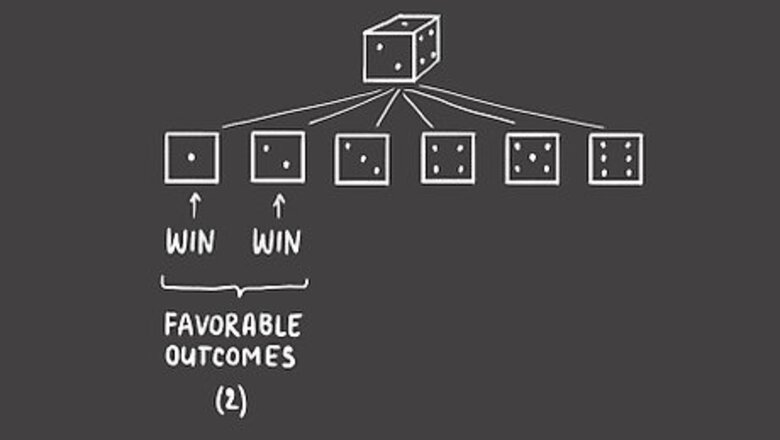
views
Calculating Basic Odds
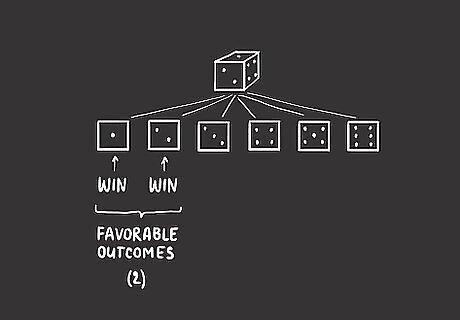
Determine the number of favorable outcomes in a situation. Let's say we're in a gambling mood but all we have to play with is one simple six-sided die. In this case, we'll just wager bets on what number the die will show after we roll it. Let's say we bet that we'll roll either a one or a two. In this case, there's two possibilities where we win - if the dice shows a two, we win, and if the dice shows a one, we also win. Thus, there are two favorable outcomes.
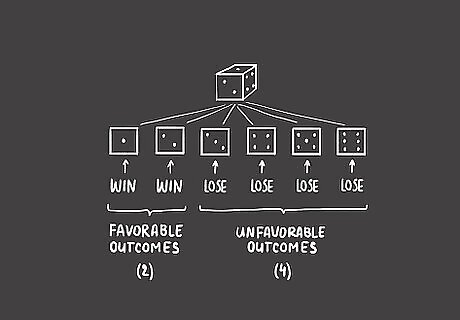
Determine the number of unfavorable outcomes. In a game of chance, there's always a chance that you won't win. Count how many outcomes there are that would cause you to lose. In the example with the die, if we bet that we'll roll either a one or a two, that means we'll lose if we roll a three, four, five, or six. Since there are four ways that we can lose, that means that there are four unfavorable outcomes. Another way to think of this is as the Number of total outcomes minus the number of favorable outcomes. When rolling a die, there are a total of six possible outcomes - one for each number on the die. In our example, then, we would subtract two (the number of desired outcomes) from six. 6 - 2 = 4 unfavorable outcomes. Similarly, you may subtract the number of unfavorable outcomes from the total number of outcomes to find the number of favorable outcomes.
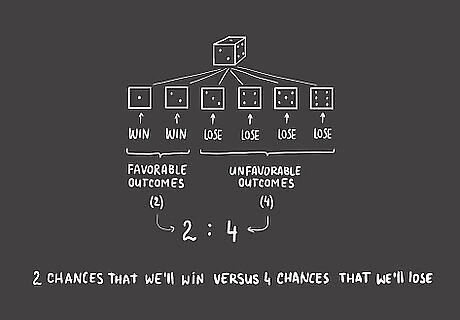
Express odds numerically. Generally, odds are expressed as the ratio of favorable outcomes to unfavorable outcomes, often using a colon. In our example, our odds of success would be 2 : 4 - two chances that we'll win versus four chances that we'll lose. Like a fraction, this can be simplified to 1 : 2 by dividing both terms by the common multiple of 2. This ratio is written (in words) as "one to two odds." You may choose to represent this ratio as a fraction. In this case, our odds are 2/4, simplified as 1/2. Note - 1/2 odds don't mean we have a one-half (50%) chance of winning. In fact, we have a one-third chance of winning. Remember when expressing odds that odds are a ratio of favorable outcomes to unfavorable outcomes - not a numerical measurement of how likely we are to win.
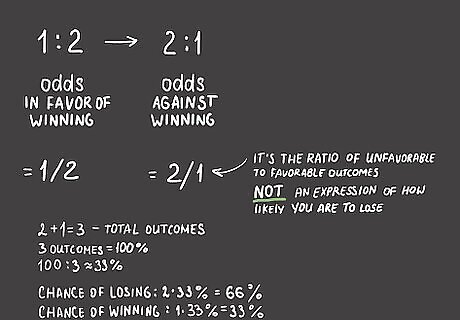
Know how to calculate odds against an event happening. The 1 : 2 odds we just calculated are the odds in favor of us winning. What if we want to know the odds of losing, also called the odds against us winning? To find the odds against us, simply flip the ratio of odds in favor of winning. 1 : 2 becomes 2 : 1. If you express the odds against winning as a fraction, you get 2/1. Remember, as above, that this isn't an expression of how likely you are to lose, but rather the ratio of unfavorable outcomes to favorable outcomes. If it were an expression of how likely you were to lose, you'd have a 200% chance of losing, which is obviously impossible. How do you like those odds? In reality, you have a 66% chance of losing - 2 chances to lose and 1 chance to win means 2 losses / 3 total outcomes = .66 = 66%
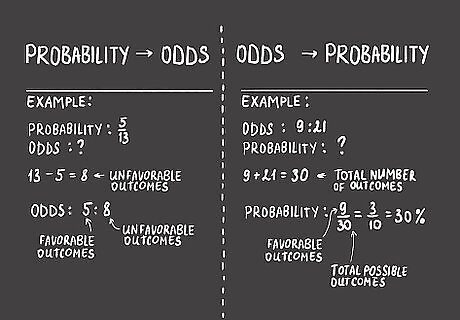
Know the difference between odds and probability. The concepts of odds and probability are related, but not identical. Probability is simply a representation of the chance that a given outcome will happen. This is found by dividing the number of desired outcomes over the total number of possible outcomes. In our example, the probability (not odds) that we'll roll a one or a two (out of six possible die roll outcomes) is 2 / 6 = 1 / 3 = .33 = 33%. So our 1 : 2 odds of winning translate to a 33% chance that we'll win. It's easy to convert between probability and odds. To find an odds ratio from a given probability, first express the probability as a fraction (we'll use 5/13). Subtract the numerator (5) from the denominator (13) : 13 - 5 = 8 . The answer is the number of unfavorable outcomes. Odds can then be expressed as 5 : 8 - the ratio of favorable to unfavorable outcomes. To find probability from a given odds ratio, first express your odds as a fraction (we'll use 9 / 21 ). Add the numerator (9) and denominator (21) : 9 + 21 = 30. The answer is the total number of outcomes. Probability can be expressed as 9/30 = 3/10 = 30% - the number of favorable outcomes over the number of total possible outcomes. A simple formula for calculating odds from probability is O = P / (1 - P). A formula for calculating probability from odds is P = O / (O + 1).
Calculating Complex Odds
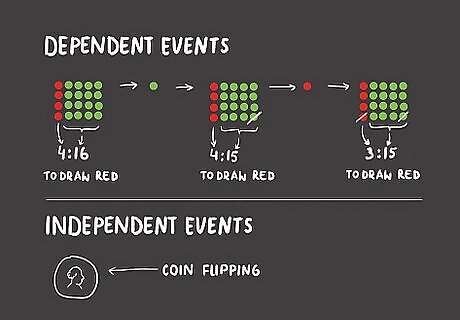
Differentiate between dependent and independent events. In certain scenarios, odds for a given event will change based on the results of past events. For example, if you have a jar full of twenty marbles, four of which are red and sixteen of which are green, you'll have 4 : 16 (1 : 4) odds to draw a red marble at random. Let's say you draw a green marble. If you don't put the marble back into the jar, on your next attempt, you'll have 4 : 15 odds to draw a red marble. Then, if you draw a red marble, you'll have 3 : 15 (1 : 5) odds on the following attempt. Drawing a red marble is a dependent event - the odds depend on which marbles have been drawn before. Independent events are events whose odds aren't effected by previous events. Flipping a coin and getting a heads is an independent event - you're not more likely to get a heads based on whether you got a heads or a tails last time.
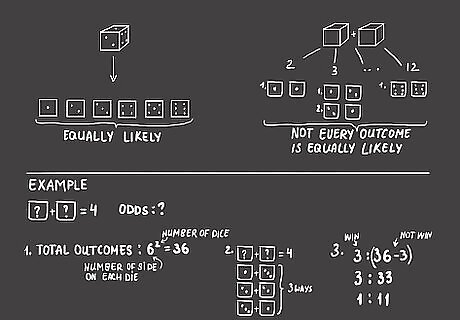
Determine whether all outcomes are equally likely. If we roll one die, it's equally likely that we'll get any of the numbers 1 - 6. However, if we roll two dice and add their numbers together, though there's a chance we'll get anything from 2 to 12, not every outcome is equally likely. There's only one way to make 2 - by rolling two 1's - and there's only one way to make 12 - by rolling two 6's. By contrast, there are many ways to make a seven. For instance, you could roll a 1 and a 6, a 2 and a 5, a 3 and a 4, and so on. In this case, the odds for each sum should reflect the fact that some outcomes are more likely than others. Let's do an example problem. To calculate the odds of rolling two dice with a sum of four (for instance, a 1 and a 3), begin by calculating the total number of outcomes. Each individual dice has six outcomes. Take the number of outcomes for each die to the power of the number of dice: 6(number of sides on each die) = 36 possible outcomes. Next, find the number of ways you can make four with two dice: you can roll a 1 and a 3, a 2 and a 2, or a 3 and a 1 - three ways. So the odds of rolling a combined "four" with two dice are 3 : (36-3) = 3 : 33 = 1 : 11 Odds change exponentially based on the number of events occurring simultaneously. Your odds of rolling a "yahtzee" (five dice that are all the same number) in one roll are very slim - 6 : 6 - 6 = 6 : 7770 = 1 : 1295!
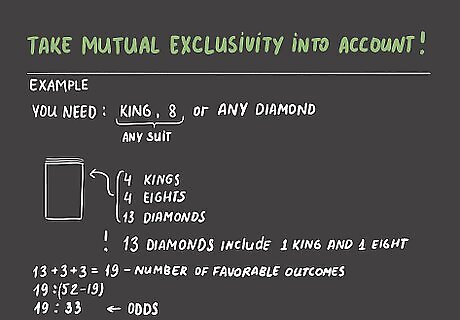
Take mutual exclusivity into account. Sometimes, certain outcomes can overlap - the odds you calculate should reflect this. For instance, if you're playing poker and you have a nine, ten, jack, and queen of diamonds in your hand, you want your next card either to be a king or eight of any suit (to make a straight), or, alternatively, any diamond (to make a flush.) Let's say the dealer is dealing your next card from a standard fifty-two card deck. There are thirteen diamonds in the deck, four kings, and four eights. However, the total number of favorable outcomes isn't 13 + 4 + 4 = 21. The thirteen diamonds already includes the king and eight of diamonds - we don't want to count them twice. The actual number of favorable outcomes is 13 + 3 + 3 = 19. Thus, the odds of being dealt a card that will give you a straight or flush are 19 : (52 - 19) or 19 : 33. Not bad! In real life, of course, if you already have cards in your hand, you're rarely being dealt cards from a complete fifty-two card deck. Keep in mind that the number of cards in the deck decreases as cards are dealt. Also, if you're playing with other people, you'll have to guess what cards they have when you're estimating your odds. This is part of the fun of poker.
Understanding Gambling Odds
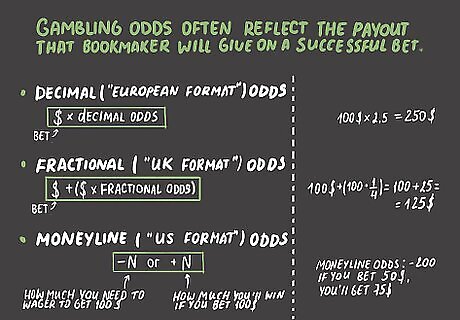
Know common formats for expressing gambling odds. If you're venturing into the world of gambling, it's important to know that betting odds don't usually reflect the true mathematical "odds" of a certain event happening. Instead, gambling odds, especially in games like horse racing and sports betting, reflect the payout that a bookmaker will give on a successful bet. For instance, if you wager $100 on a horse with 20:1 odds against him, this doesn't mean that there are 20 outcomes where your horse loses and 1 where he wins. Rather, it means that you'll be paid 20 times your original wager - in this case, $2,000! To add to the confusion, the format for expressing these odds sometimes varies regionally. Here are a few non-standard ways that gambling odds are expressed: Decimal (or "European format") odds. These are fairly easy to understand. Decimal odds are simply expressed as a decimal number, like 2.50. This number is the ratio of the payout to the original stake. For instance, with odds of 2.50, if you bet $100 and win, you'll receive $250 dollars - 2.5 times your original stake. In this case, you'll make a tidy profit of $150. Fractional (or "UK format") odds. These are expressed as a fraction, like 1/4. This represents the ratio of the profit (not total payout) from a successful bet to the stake. For instance, if you bet $100 on something with 1/4 fractional odds and win, you'll profit by 1/4 of your original stake - in this case, your payout will be $125 for a profit of $25. Moneyline (or "US format") odds. These can be difficult to understand. Moneyline odds are expressed as a number preceded by a minus sign or a plus sign, like -200 or +50. A minus sign means the number represents how much you need to wager to make $100. A positive sign means the number represents how much you'll win if you bet $100. Remember this subtle distinction! For example, if we wager $50 with moneyline odds of -200, when we win, we'll get a payout of $75 for a total profit of $25. If we wager $50 with moneyline odds of +200, we'll get a payout of $150 for a total profit of $100. In moneyline odds, a simple "100" (no plus or minus) represents an even bet - whatever money you stake, you'll earn as profit if you win.
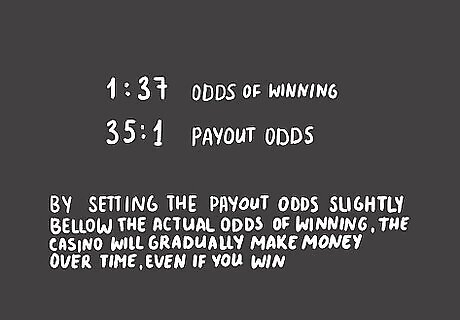
Understand how gambling odds are set. The odds that bookmakers and casinos set aren't usually calculated from the mathematical probability that certain events will occur. Rather, they're carefully set so that, in the long run, the bookie or casino will make money, regardless of any short-term outcomes! Take this into account when making your bets - remember, eventually, the house always wins. Let's look at an example. A standard roulette wheel has 38 numbers - 1 through 36, plus 0 and 00. If you bet on one space (let's say 11 ), you have 1 : 37 odds of winning. However, the casino sets the payout odds at 35 : 1 - if the ball lands on 11, you'll win 35 times your original stake. Notice that the payout odds are slightly lower than the odds against you winning. If casinos weren't interested in making money, you would be paid out at 37 : 1 odds. However, by setting the payout odds slightly below the actual odds of you winning, the casino will gradually make money over time, even if it has to make the occasional large payout when the ball lands on 11.

Don't fall prey to common gambling fallacies. Gambling can be fun - even addictive. However, certain widely-circulated gambling strategies that at first appear to be "common sense" are, in fact, mathematically false. Below are just a few things you should keep in mind when you go gambling - don't lose more money than you have to! You're never "due" to win. If you've been at the Texas Hold 'Em table for an hour and you haven't been dealt a single good hand, you may want to stay in the game in the hopes that a winning straight or flush is "right around the corner." Unfortunately, your odds don't change with the amount of time you've been gambling. The cards are randomly shuffled before every deal, so if you've had ten bad hands in a row, you're just as likely to get another bad hand as you are if you've had a hundred bad hands in a row. This extends to most other games of chance - roulette, slots, etc. Sticking with one specific bet won't increase your odds. You may know someone who has "lucky" lotto numbers - though it can be fun to bet money on numbers that have special personal meaning, in random games of chance, you're never more likely to win by betting on the same thing every time than you are by betting on a different thing every time. Lottery numbers, slots, and roulette wheels are completely random. In roulette, for example, it's just as likely that you'll roll "9" three times in a row as it is that you'll roll any specific three numbers in order. If you're one away from the winning number, you weren't "close." If you pick the number 41 for the lottery and the winning number is revealed as 42, you may feel absolutely crushed, but cheer up! You weren't even close. Two numbers that are close together, like 41 and 42, aren't mathematically connected in any way in random games of chance.
















Comments
0 comment